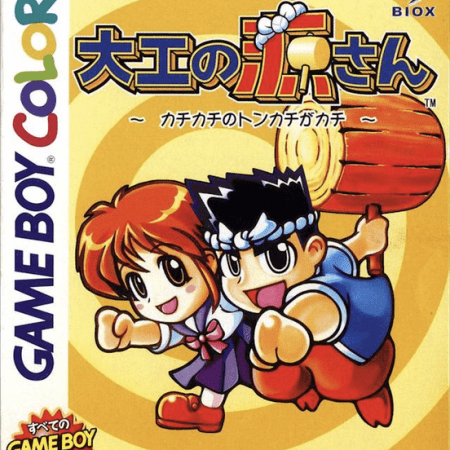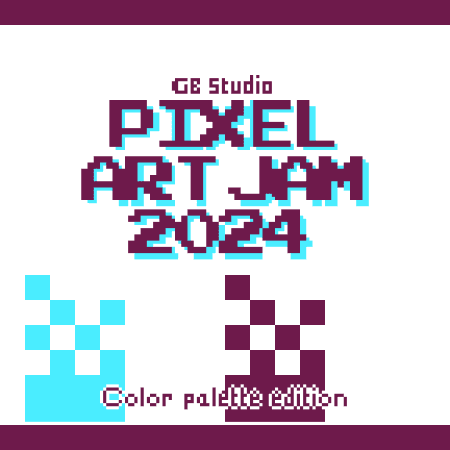By the time the Game Boy Color was nearing the end of its illustrious commercial lifespan, many top notch puzzle games had been released. Relatively few could be placed in the puzzle-platformer sub-category, but games such as Toki Tori and Donkey Kong ’94 have aged very well all things considered, and certainly saw their fair share of commercial success back in the day. It seems the puzzle-platformer is just a great fit for the little handheld that could – at least to me, anyway. It’s shocking then that this next title in the GB Classics Spotlight series never officially made it to a western audience.
Gen the Carpenter: Smash Smash Hammer Smash (known as Daiku no Gen-san: Kachikachi no Tonkachi ga Kachi in Japan) was developed by Biox and released exclusively in Japan in 2000 by the same company that brought us Noobow; Irem.
Gen the Carpenter first came to arcades as an action-platformer in 1990 and found considerable success. It made sense then for Irem to adapt the series to consoles soon after. Gen-san, with his weaponized wooden mallet, was rebranded as Hammerin’ Harry to suit a western market and let loose upon the world at large. In 1992, Irem released Hammerin’ Harry: Ghost Building Company on the Game Boy, but its seems the title received a lukewarm reception at best. That would be the last time Hammerin’ Harry would be seen beyond Asia until 2008, a full sixteen years later, when he made a return in Hammerin’ Hero on the PSP. All of these titles were developed to emulate the action packed game play seen in games such as Ninja Gaiden Shadow, so Gen the Carpenter: Smash Smash Hammer Smash, with it’s much more subdued puzzler pace, is the outlier in the series. All the same, it shares all the hallmarks of a fantastic puzzle game that leaves me wondering why those in charge never sought to unleash this upon a wider global audience. Luckily for us though, Daiku no Gen-san: Kachikachi no Tonkachi ga Kachi has since been fan translated to English by Pentarou.
The story is straightforward enough. The evil capitalist President Kuromoku together with Dr Parallel, have built an army of robots and sent them marching through the big city to extort money from its many citizens. Amongst the havoc, Gen’s girlfriend Kanna has been swept up and kidnapped. Gen must traverse various locations throughout the city in order to track her down and stop the evil doers!
The game consists of sixteen rather large stages split over four worlds, each culminating in a part action, part puzzler Boss fight with a final stage that pits Gen against the great Kuromoku himself. Gen can switch at will between three carpenters’ hammers, using their unique properties to solve puzzles in order to progress through each stage.
The Wooden Hammer turns enemies into blocks that can either be pushed or hit once more, sliding across the screen until collision. The Metal Hammer interacts with magnets and can smash the previously mentioned blocks, causing the associated enemy to re-spawn, thus enabling the player to retry a puzzle. Finally, there is the Pico Hammer. This one aggravates enemies, compelling them to follow Gen whenever possible. The effects of each hammer typically allow the player to operate switches, open paths or turn on ladders or springboards and much more. The hammers provide the foundations of a satisfying puzzle experience.
As with the wonderfully designed Catrap, Gen the Carpenter: Smash Smash Hammer Smash does an excellent job of tutorializing how the game play works using a combination of subtle suggestion and competent level design (and without the use of any text!). But what this game really excels at, is its implementation of optional collectibles.
Optional collectibles are just that – optional. Therefore, you won’t find them on the critical path – the route the player must take to complete the game. Instead, they offer a number of additional wrinkles to the player experience:
- They can provide additional challenges for players that are familiar with that particular genre of game, while also remaining accessible to beginners.
- They offer additional content in the form of replayability when a player has completed the game but still wishes to continue playing.
- They can expand the scope and variety of game play. For example, increase periods of exploration.
- They allow an individual player to set their own in-game goals without burdening those players that wouldn’t otherwise be interested in completing everything a particular game has to offer.
In the case of Gen the Carpenter: Smash Smash Hammer Smash, the star collectible, of which there are six to find per stage, asks the player to search high and low for hidden stars, solve relatively harder optional puzzles, or make use of an advanced player move-set that is (at first) not immediately obvious. It is this latter category that is most interesting. Certainly among Game Boy games, this concept is rarely explored but can offer considerably more depth to game play for those that wish to take advantage of it – especially if you are interested in speedrunning.
But what exactly do I mean by an advanced player move-set that isn’t immediately obvious?
It can be as simple as a run button as seen in the plethora of platformers out there, but that’s just the tip of the iceberg. Some more interesting examples include Super Metroid on the SNES which has the player learning how to wall jump and shine spark if the player is paying attention to the native animals of Zebes (and that’s just the beginning!). Or the advanced move-set found in 2018’s Celeste, which was specifically designed with completely optional advanced maneuvers – only necessary for those players that wanted to continue playing beyond the credits or begin speedrunning the game. Put basically (and very vaguely to be honest); it’s any controllable characteristic that is beyond the basic move-set of the player character NOT overtly taught using a tutorial of some kind.
Let’s take a look at how the developers at Biox explored hidden advanced player move-sets and optional collectibles in Gen the Carpenter: Smash Smash Hammer Smash.
Before I continue however, I would like to provide a fair warning:
SPOILERS AHEAD!
If you like the sound of Gen the Carpenter: Smash Smash Hammer Smash, I encourage you to track down a copy and discover all of its secrets for yourself before reading any further. Now that that’s out of the way though, let’s continue…
As mentioned earlier, the initial stage does a great job of slowly teaching the player how to progress through the game by drip feeding information relating to what will turn out to be a series of complex game play elements. Some collectible stars are placed in locations that require little to no effort to collect at the outset (in keeping with introductory level design techniques) but even by the time the player has finished stage 1-1, there will be a few collectible stars the player has crossed paths with, but as the solution requires advanced moves, the player will likely assume that the collectible was currently unobtainable and, like me, the player will probably move on to complete the stage without collecting everything.
Here’s an example:
When I first played through the game, I could not for the life of me figure out how to get the collectible shown in the above screenshot. Gen can jump with a press of the A Button, but the collectible is just out of reach. I assumed I would solve some puzzle later on, allowing me to collect the star before long. I continued on and finished 1-1, realizing that I had missed a few of the stars in the process.
A few stages later, I came across an obstacle that required me to jump one block higher than the normal jump allows. This time I wasn’t dealing with an optional collectible, I was on the critical path! The developers were asking me to learn a move that would allow me to not only progress but also collect the previously out of reach collectible!
By jumping with A and then holding Down and pressing B while in the air, the player can perform a ‘Hammer Jump’. Gen will begin bouncing on his hammer as if it were a Pogo stick, allowing him to pogo into the air for some extra height!
Further into the level, another obstacle asked me to not only figure out a new advanced maneuver, but also stack two together. In particular, they were the Hammer Jump to what I will call the ‘Hammer Pop‘. While performing the Hammer Jump, Gen can execute the Hammer Pop by swinging his hammer at the apex of the jump, knocking it against a ledge corner. This collision pops him up a few more pixels, enabling him to reach what otherwise seemed to be an impossibly high platform. Now, that’s a complex series of button presses to read on paper, let alone figure out on your own! So much so that they tend to be discovered not when faced with an optional challenge, but a mandatory one. And even then, it’s a bit of a stretch to expect every player to figure it out without the help of either an instruction manual or the internet…
This was a great moment during my experience with Gen the Carpenter: Smash Smash Hammer Smash. It was then that I realized many of the collectible stars were not just additional game content, but subtly hinting at a range of more complex and nuanced maneuvers at my disposal!
I have since completed the game, gone back and gathered all the collectibles and even begun timing myself, trying to beat my own PB’s. I ask myself why I would continue to play this game, given that I have seen and completed everything the developers cared to create? My answer to this is these advanced maneuvers provide a level of depth and joy that offer something beyond 100 percenting the game. For the same reason people want to speedrun as Madeline in Celeste, it’s just inherently fun to play as Gen, especially when you know all the ins and outs of his full move-set.
Luckily for fans of Daiku no Gen-san: Kachikachi no Tonkachi ga Kachi, Biox went on to produce their final game before the company unfortunately had to shut their doors for good. One that was arguably better in every respect and very much a spiritual sequel to this title…
In early 2001, Samurai Kid was released exclusively in Japan… and this one has an in-game timer! We’ll take a look at it in the next Classic Spotlight.

Independent Games Designer, Artist, Film Enthusiast and Full-time Dad (he/him). Check out my games here!





